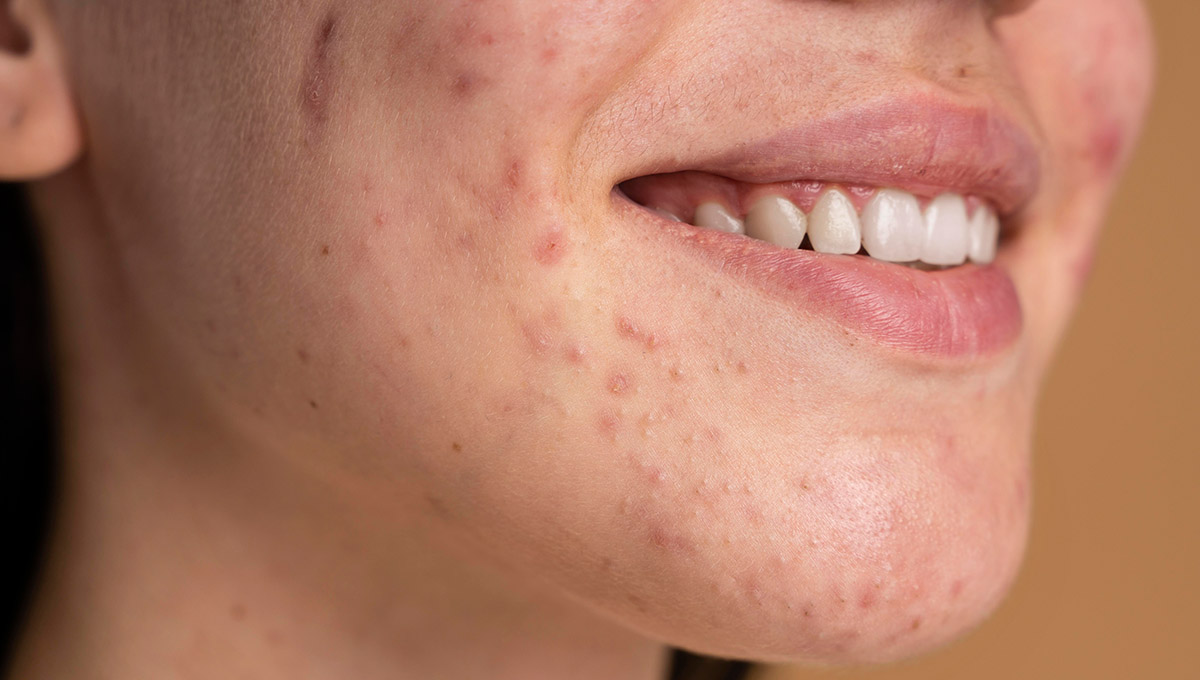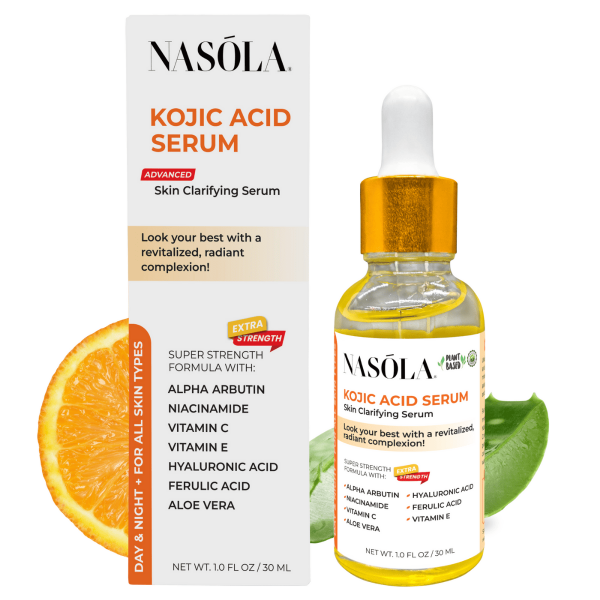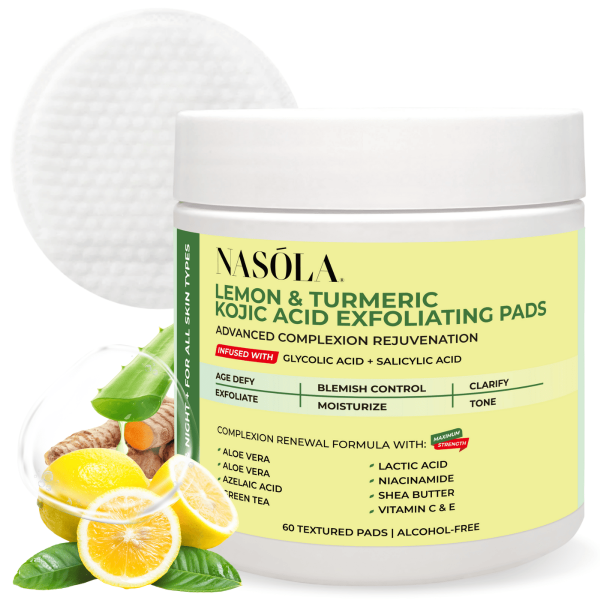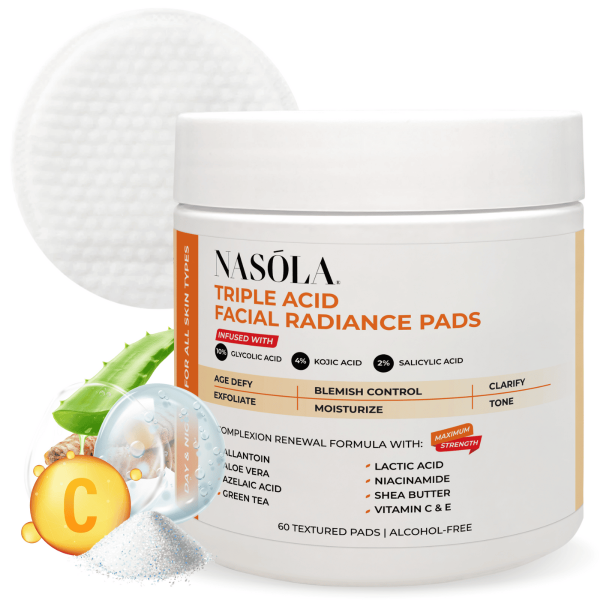Is niacinamide good for rosacea? Before we answer that question, if you’ve ever looked in the mirror and felt frustrated by the nonstop redness, sensitivity, or stinging on your cheeks—you’re not alone.
Rosacea can feel like your skin is constantly on edge… and avoiding triggers becomes a full-time job. Which brings us to this question that’s popping up everywhere.
This quiet little ingredient has been sneaking into all our favorite products lately. It’s calming. It’s balancing. And rumor has it… it’s GOOD for rosacea.
But is that just skincare gossip? Or is it legit?
If you’ve been endlessly scanning ingredients and hoping for a solution that won’t turn your face into a tomato (literally), today’s post is for you.
We’re exploring the science behind niacinamide, and how skin-friendly products like Nasola Triple Acid Facial Radiance Pads, Nasola Lemon Turmeric Kojic Acid Exfoliating Pads, Nasola Kojic Acid Serum and Nasola Kojic Acid Facial Toner can actually help.
So if you’re done playing guessing games with your skincare, keep reading ✨
- Is Niacinamide Good for Rosacea? Understanding Its Benefits
- Niacinamide Rosacea Before and After: Real People, Real Results
- Using Chemical Exfoliation Carefully with Rosacea
- Balancing Rosacea Skin with Toners and Serums
- Ingredient Focus: Niacinamide’s Multi-Tasking Role in Rosacea Care
- Building a Rosacea-Friendly Skincare Routine with Niacinamide
- Frequently Asked Questions
Is Niacinamide Good for Rosacea? Understanding Its Benefits
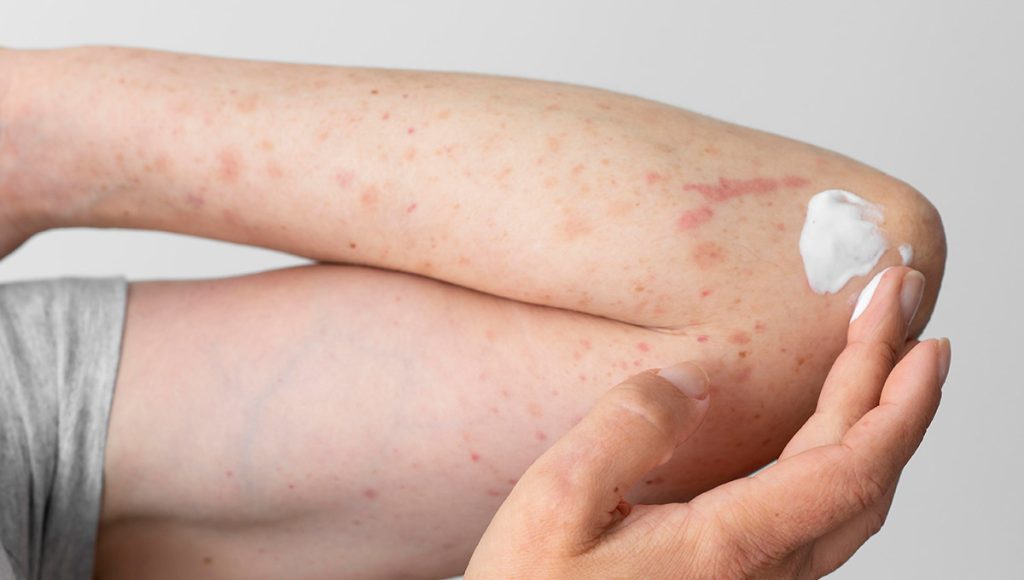
Niacinamide, a form of vitamin B3, is no longer the skincare industry’s best-kept secret—it’s the gentle giant making a lot of noise for all the right reasons.
When it comes to rosacea—a condition that already makes your skin feel like it’s walking on eggshells—niacinamide steps in like a reassuring friend.
One of the reasons it works? It doesn’t just address redness; it gets to the root of sensitivity. This ingredient helps your skin retain moisture, strengthens the barrier, and seriously dials down inflammation—in clinical studies, in reviews, and yes, in real life.
Let’s unpack why many dermatologists are calling it a must-have for sensitive skin.
How Niacinamide Strengthens the Skin Barrier for Rosacea Sufferers
For anyone with rosacea, the word ‘barrier’ isn’t just skincare lingo—it’s survival. The moment your skin loses that barrier function, all chaos breaks loose: flare-ups, burning, itching… the works.
Niacinamide plays a crucial role in ceramide production, which helps lock in moisture and keep irritants out.
Here’s what niacinamide helps do at the barrier level:
- Supports ceramide synthesis to keep skin hydrated
- Boosts resiliency and bounce in the outer skin layer
- Minimizes trans-epidermal water loss (TEWL)
- Soothes skin reactions linked to environmental triggers
When your skin barrier is protected, your overall sensitivity decreases. This is why niacinamide is often one of the first things recommended to rosacea patients by skincare professionals.
Why Dermatologists Recommend Niacinamide for Sensitive, Rosacea-Prone Skin
Dermatologists appreciate niacinamide because it delivers calming power without the irritation usually found in stronger actives. Studies highlight its ability to reduce redness, calm moderate inflammation, and even stimulate fibroblasts to help with skin repair over time.
It pairs well with other ingredients like hyaluronic acid and kojic acid—especially in formulated blends like the Nasola Kojic Acid Serum, where niacinamide works in harmony to fade pigmentation while comforting the skin.
Niacinamide Rosacea Before and After: Real People, Real Results
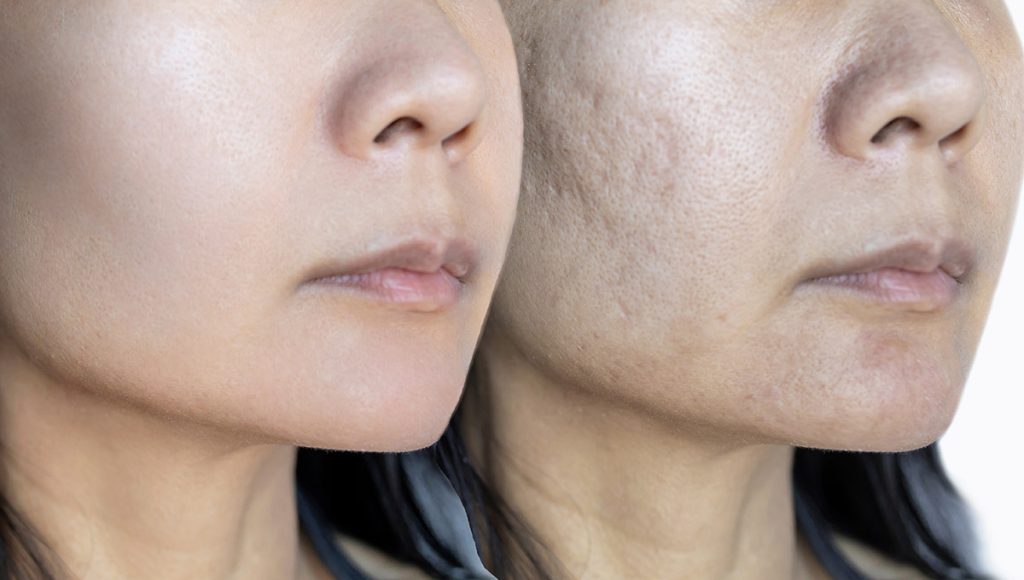
Sometimes the best proof isn’t in the science—it’s in the mirror. The niacinamide rosacea before and after transformation stories are encouraging, with visible differences in redness, skin texture, and flare-up frequency after consistent use. While niacinamide isn’t a miracle overnight cure (nothing is, really), it can make a big difference within weeks.
Many users report that their skin begins to feel less reactive within the first 2–4 weeks, with clearer skin and fewer breakouts by week 6.
Want to know what to expect? Let’s look at the two areas most people see changes in.
Visible Reduction in Redness and Flare-Ups
One of the most noticeable improvements comes in the form of calm skin—less blotchiness, fewer surprise flare-ups, and a significant reduction in redness.
Even those who had almost given up see results. Niacinamide reduces the dilation of blood vessels on the skin’s surface, which often causes the rosacea color signature (hello, uninvited pink cheeks).
Common user-reported improvements after niacinamide:
- Diminished chronic redness (especially around the nose and cheeks)
- Fewer visible capillaries with consistent use
- Soothing burning or stinging sensations
- Noticeable change in tone in early morning and post-cleanse phases
For example, with Nasola Kojic Acid Serum, users not only experienced a more even tone but also reported enjoying a lightweight, calming serum that’s perfect for sensitive-prone skin routines.
Improved Skin Texture and Barrier Function After Consistent Use
Rosacea isn’t just about redness—it changes skin texture too. Patches can become rough, flaky, or bumpy, making makeup a nightmare and bare skin feel dry and stretched.
Niacinamide, with its anti-inflammatory power, boosts barrier performance and enhances smoothness over time.
Here’s what textures usually improve:
- Flaky or dry patches become softer
- Bumps and unevenness around cheeks smooth out
- Foundation sits better on well-hydrated skin
- Skin feels resilient thanks to consistent hydration and inflammation support
Keeping a steady routine is key. Don’t rush it or surf from product to product—give niacinamide a proper trial (4–6 weeks). Pair it with hydration heroes like a calming toner or serum, and don’t skip protection: sunscreen’s still critical daily.
Using Chemical Exfoliation Carefully with Rosacea
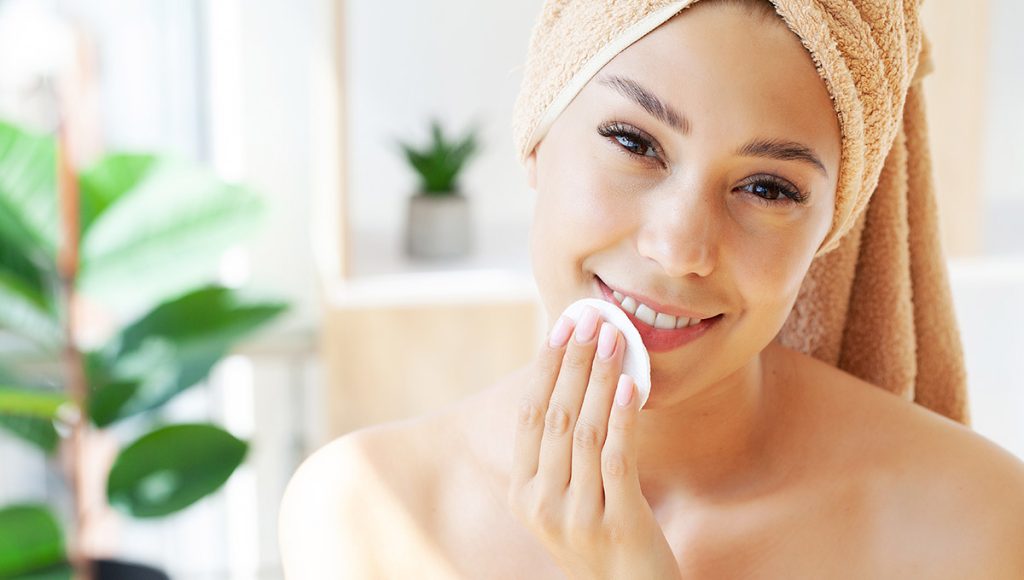
Let’s be honest—exfoliation sounds scary when your skin is already ticked off.
But hear us out: when done GENTLY and intentionally, even rosacea-prone skin can benefit from exfoliation. It helps renew dull patches, smooth the texture, and even fade hyperpigmentation caused by flare-ups.
The trick? Choose mild formulations, exfoliate no more than 1–2x per week, and always—ALWAYS—follow up with moisture. Here’s what your skin actually appreciates when it comes to gentle, smart exfoliation.
The Role of Kojic Acid in Reducing Hyperpigmentation from Rosacea Flare-Ups
Hyperpigmentation doesn’t just happen after acne—rosacea has its own signature color story, too, especially after a strong flush. Kojic acid helps lighten these post-inflammatory marks by interrupting melanin production.
You’ll find kojic acid in the Nasola Lemon Turmeric Kojic Acid Exfoliating Pads—a unique combo of brightening turmeric and calming botanicals that create a rejuvenating effect without the sting. It’s exfoliation with restraint, and rosacea-prone skin LOVES restraint.
Benefits of kojic acid for rosacea discoloration:
- Helps fade pink or brown spots left behind from flare-ups
- Brightens uneven skin tone caused by inflammation
- Encourages gentle resurfacing layered with anti-inflammatories
- Supports niacinamide to clarify and calm simultaneously
Safe Techniques for Exfoliating Rosacea-Prone Skin
Over-scrubbing? That’s a recipe for disaster with rosacea. Instead, think of exfoliation like sweeping your skin clean—half-hearted scrubbing isn’t required.
Chemical exfoliation (like gentle AHA/BHA blends) is typically better tolerated than physical ones.
Try the Nasola Triple Acid Facial Radiance Pads, which bring mandelic, lactic, and glycolic acids together in a low-dose form. These pads remove dullness while niacinamide helps restore balance. Win-win.
Best exfoliation tips for sensitive skin:
- Use chemical pads 1–2 times a week MAX
- Avoid fragrance and high alcohol content
- Follow immediately with a barrier-repairing toner or serum
- Use at night to avoid sun-triggered sensitivity
Balancing Rosacea Skin with Toners and Serums
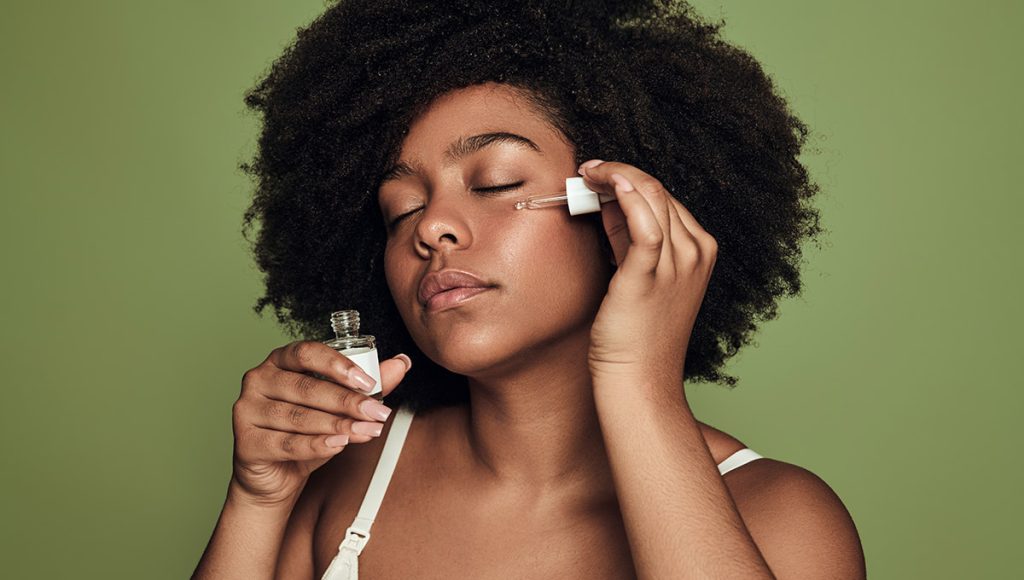
Balance is key when managing rosacea. You’re constantly playing defense AND offense: soothing inflammation while trying to fade old spots and prevent new ones. Step in: gentle toners and calming serums.
These help prep your skin to absorb moisture, reduce sensitivity, and neutralize irritants before they become a problem. When formulated correctly (and with niacinamide), toners and serums become your calm in the skincare storm.
The Importance of Hydration in Managing Rosacea Symptoms
Rosacea and dehydration? Not. A. Good. Match. If your skin’s water-deprived, sensitivity goes through the roof. Hydrating ingredients help reinforce the barrier against air pollution, sun, stress, and other common triggers.
Why hydration should be your non-negotiable:
- Helps skin tolerate active ingredients without burning
- Minimizes tightness, flakiness, and dullness
- Supports niacinamide in barrier repair duties
- Sets a more comfortable stage for make-up wearers
Look for hydrating toners like the Nasola Kojic Acid Facial Toner—it’s lightweight, niacinamide-rich, and splash-free. Bonus: it helps with skin clarity too.
The Best Kojic Acid-Based Toners for Sensitive Skin
There’s a reason kojic acid is appearing in more rosacea-friendly products—it brightens dull or blotchy skin without bleaching or stripping. But not all kojic acid formulas are created equal.
Gentle options, like the Nasola Kojic Acid Facial Toner, combine kojic with niacinamide, cucumber extract, and calming hydrators to soothe inflammation and improve texture. It gives you that refreshing ‘aaaah’ without the sting.
Benefits of a kojic-acid-based toner for rosacea:
- Provides even, radiant skin tone without harshness
- Calms inflammation while targeting old pigmentation
- Preps skin for niacinamide serums or moisturizers
- Supports daily protection and bounce-back resilience
Ingredient Focus: Niacinamide’s Multi-Tasking Role in Rosacea Care
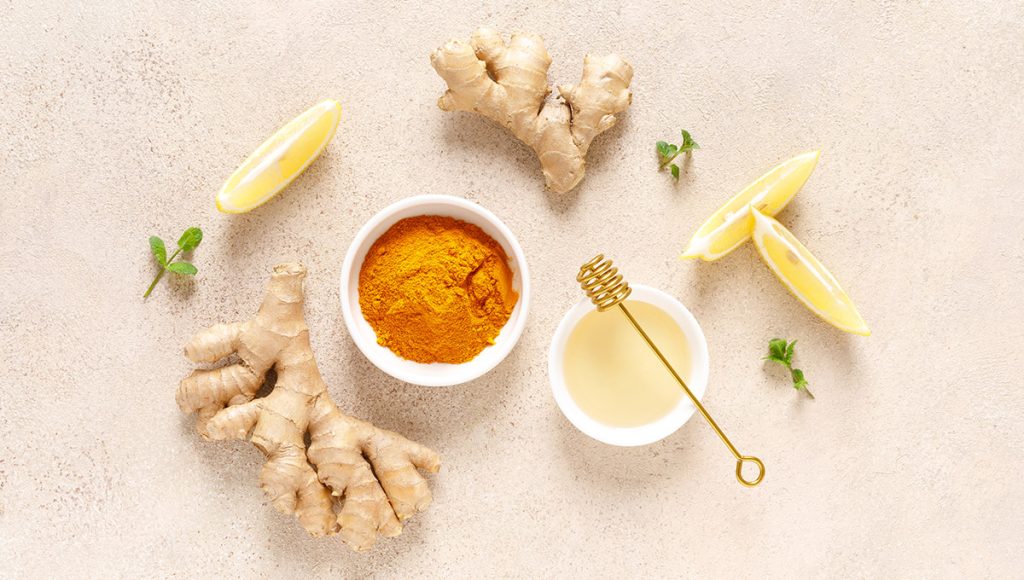
Let’s zoom in on our star player: niacinamide. 🌟 While it’s clearly great for calming flare-ups, it does so much more behind the scenes.
This is one of those ingredients that juggles several responsibilities without dropping the ball.
Niacinamide works on texture, tone, moisture, and inflammation—all at once. And for rosacea-prone skin, that kind of multitasking really matters.
Anti-inflammatory Effects and Barrier Strengthening Properties
Niacinamide targets a key process involved in rosacea: inflammation. It works on cytokines (tiny chemical messengers) that trigger swelling and redness. At the same time, it strengthens ceramide production, building up your skin’s natural shield.
Why it matters:
- Inflammation becomes more predictable and less intense
- Skin holds onto vital hydration
- Redness reduces without using steroids
- Long-term use improves resilience
Pairing Niacinamide with Active Acids Like Kojic Acid Safely
Trying to mix niacinamide with actives like kojic acid might seem risky at first—but if done right, it can be a game changer. The key is to use items specially formulated to balance both ingredients.
Like… the Nasola Kojic Acid Serum. This serum blends niacinamide and kojic acid seamlessly. No burning, no sticky residue. Just clarity, calm, and smooth skin in one format.
Blending tips:
- Avoid layering too many new actives at once
- Opt for pre-formulated combos over DIY layer cakes
- Space ingredients out (apply kojic in the evening, niacinamide in the morning if needed)
- Hydrate between layers for buffering effect
Building a Rosacea-Friendly Skincare Routine with Niacinamide
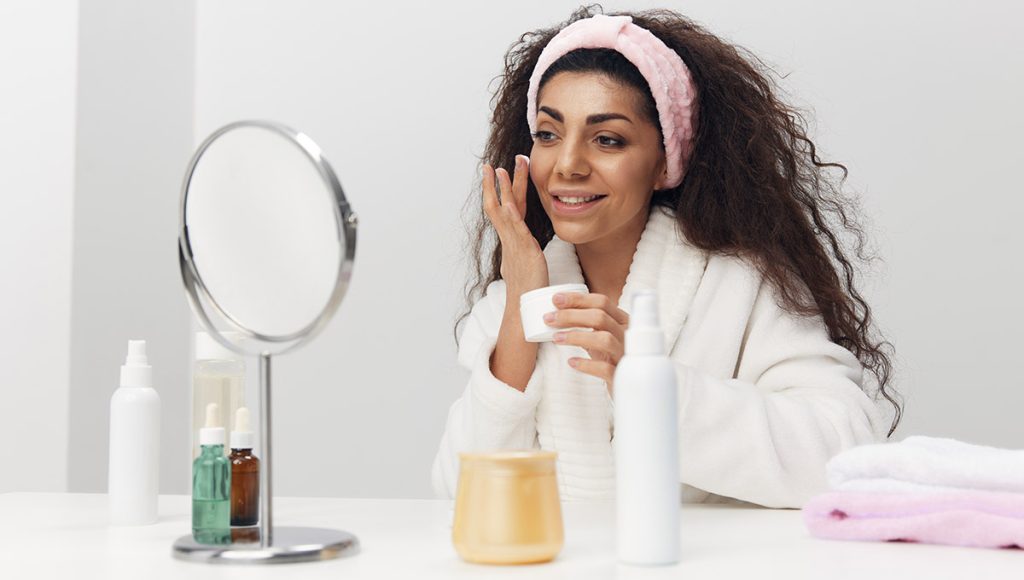
So now you know niacinamide works—but where do you start if your skin’s been through the wringer? With a plan. A simple, manageable routine that works with your sensitivity, not against it.
Consistency is everything when working with rosacea. And when layering niacinamide, you NEED to avoid the rookie mistakes. Let’s break down what a gentle-but-effective routine looks like.
Step-by-Step Routine Using Niacinamide and Kojic Acid
A routine built for rosacea should never feel like a 10-step slog. Less is more when your skin is temperamental.
Try this simplified approach:
- Cleanse – Use a non-foaming gel cleanser
- Tone – Apply Nasola Kojic Acid Facial Toner with a cotton pad or pat in with hands
- Treat – Use Nasola Kojic Acid Serum nightly or every other night
- Exfoliate – 1–2x week with Nasola Lemon Turmeric Kojic Acid Exfoliating Pads
- Moisturize – Use a simple, fragrance-free barrier cream
Common Mistakes to Avoid When Treating Rosacea With Active Ingredients
Even gentle actives like niacinamide can go wrong if not used smartly. Don’t sabotage your own glow-up journey with basic mistakes.
Watch out for:
- Over-layering: Too many active products can backfire
- Inconsistent use: Jumping routines slows progress
- No patch testing: Even niacinamide can trigger reactions in some
- Ignoring SPF: UV worsens rosacea and stops any progress
Frequently Asked Questions
Yes, niacinamide is generally very good for rosacea! It reduces redness and inflammation while strengthening the skin barrier. It’s non-irritating and highly recommended for sensitive skin. Always patch test when trying any new product.
Most people see visible improvements in 4–6 weeks. Common changes include reduced redness, less irritation, fewer flare-ups, and smoother skin. Products like Nasola Kojic Acid Serum support a more even complexion while calming the skin.
Yes, if the formulation is gentle. Look for dual-ingredient blends like Nasola Lemon Turmeric Kojic Acid Exfoliating Pads that reduce inflammation and support barrier health.
Try Nasola Kojic Acid Facial Toner. It contains niacinamide and kojic acid to soothe and brighten irritated, red-toned skin.
Yes, when they’re formulated for sensitivity. Nasola Triple Acid Facial Radiance Pads are a great example—they combine gentle acids with soothing agents and are pH-balanced.

